The Influence on Post-Activation Potentiation Exerted by Different Degrees of Blood Flow Restriction and Multi-Levels of Activation Intensity
Abstract
1. Introduction
2. Methods
2.1. Participants
2.2. General Overview of Experimental Design
2.3. Experimental Sessions
2.4. Statistical Analysis
3. Results
4. Discussion
5. Limitations
6. Conclusions
7. Practical Implications
- (1)
- The 30–50% BFR combine with 30–50% 1RM resistance exercise can replace 90% 1RM traditional exercise as a means of activation during warm up section.
- (2)
- Athletes in need can perform BFR-30-30 before the training or race is about to start, or finish BFR-30-50, BFR-50-50 4 min before for activation, their choice should according to the time interval between the end of warm-up and the start of the race.
- (3)
- The longer PAP duration after the specific BFRT activation procedure is more reliable for athletes to maintain high level sports performance.
- (4)
- Competitive teams should encourage BFRT for activation to reduce the transportation burden on the team during the competition.
Author Contributions
Funding
Institutional Review Board Statement
Informed Consent Statement
Acknowledgments
Conflicts of Interest
References
- Till, K.A.; Cooke, C. The Effects of Postactivation Potentiation on Sprint and Jump Performance of Male Academy Soccer Players. J. Strength Cond. Res. 2009, 23, 1960–1967. [Google Scholar] [CrossRef]
- Brown, I.E.; Loeb, G.E. Post-Activation Potentiation—A Clue for Simplifying Models of Muscle Dynamics. Am. Zool. 1998, 38, 743–754. [Google Scholar] [CrossRef]
- Kilduff, L.P.; Owen, N.; Bevan, H.; Bennett, M.; Kingsley, M.I.; Cunningham, D. Influence of Recovery Time on Post-Activation Potentiation in Professional Rugby Players. J. Sports Sci. 2008, 26, 795–802. [Google Scholar] [CrossRef] [PubMed]
- Gołaś, A.; Maszczyk, A.; Zajac, A.; Mikołajec, K.; Stastny, P. Optimizing Post Activation Potentiation for Explosive Activities in Competitive Sports. J. Hum. Kinet. 2016, 52, 95–106. [Google Scholar] [CrossRef]
- Lowery, R.P.; Duncan, N.M.; Loenneke, J.P.; Sikorski, E.M.; Naimo, M.A.; Brown, L.E.; Wilson, F.G.; Wilson, J.M. The Effects of Potentiating Stimuli Intensity under Varying Rest Periods on Vertical Jump Performance and Power. J. Strength Cond. Res. 2012, 26, 3320. [Google Scholar] [CrossRef] [PubMed]
- Kilduff, L.P.; Cunningham, D.J.; Owen, N.J.; West, D.J.; Bracken, R.M.; Cook, C.J. Effect of Postactivation Potentiation on Swimming Starts in International Sprint Swimmers. J. Strength Cond. Res. 2011, 25, 2418–2423. [Google Scholar] [CrossRef] [PubMed]
- Kilduff, L.P.; Bevan, H.R.; Kingsley, M.I.; Owen, N.J.; Bennett, M.A.; Bunce, P.J.; Hore, A.M.; Maw, J.R.; Cunningham, D.J. Postactivation Potentiation in Professional Rugby Players: Optimal Recovery. J. Strength Cond. Res. 2007, 21, 1134–1138. [Google Scholar] [CrossRef]
- Izquierdo, M.; Häkkinen, K.; Gonzalez-Badillo, J.J.; Ibáñez, J.; Gorostiaga, E.M. Effects of Long-Term Training Specificity on Maximal Strength and Power of the Upper and Lower Extremities in Athletes from Different Sports. Eur. J. Appl. Physiol. 2002, 87, 264–271. [Google Scholar] [CrossRef]
- Baker, D. Acute Effect of Alternating Heavy and Light Resistances on Power Output During Upper-Body Complex Power Training. J. Strength Cond. Res. 2003, 17, 493–497. [Google Scholar]
- Miarka, B.; Del Vecchio, F.B.; Franchini, E. Acute Effects and Postactivation Potentiation in the Special Judo Fitness Test. J. Strength Cond. Res. 2011, 25, 427–431. [Google Scholar] [CrossRef]
- Abe, T.; Kawamoto, K.; Yasuda, T.; Kearns, C.F.; Midorikawa, T.; Sato, Y. Eight Days Kaatsu-Resistance Training Improved Sprint but Not Jump Performance in Collegiate Male Track and Field Athletes. Int. J. Kaatsu Train. Res. 2005, 1, 19–23. [Google Scholar] [CrossRef]
- Tomohiro, Y.; Fukumura, K.; Tomaru, T.; Nakajima, T. Thigh Muscle Size and Vascular Function after Blood Flow-Restricted Elastic Band Training in Older Women. Oncotarget 2016, 7, 33595. [Google Scholar]
- Luebbers, P.E.; Witte, E.V.; Oshel, J.Q.; Butler, M.S. Effects of Practical Blood Flow Restriction Training on Adolescent Lower-Body Strength. J. Strength Cond. Res. 2019, 33, 2674–2683. [Google Scholar] [CrossRef] [PubMed]
- Taylor, C.W.; Ingham, S.A.; Ferguson, R.A. Acute and Chronic Effect of Sprint Interval Training Combined with Postexercise Blood-Flow Restriction in Trained Individuals. Exp. Physiol. 2016, 101, 143–154. [Google Scholar] [CrossRef] [PubMed]
- Pignanelli, C.; Christiansen, D.; Burr, J.F. Blood Flow Restriction Training and the High-Performance Athlete: Science to Application. J. Appl. Physiol. 2021, 130, 1163–1170. [Google Scholar] [CrossRef]
- Loenneke, J.P.; Thiebaud, R.S.; Abe, T.; Bemben, M.G. Blood Flow Restriction Pressure Recommendations: The Hormesis Hypothesis. Med. Hypotheses 2014, 82, 623–626. [Google Scholar] [CrossRef]
- Jongsoon, K.L. Changes of Compound Muscle Action Potential after Low-Intensity Exercise with Transient Restriction of Blood Flow: A Randomized, Placebo-Controlled Trial. J. Phys. Ther. Sci. 2009, 21, 361–366. [Google Scholar]
- Abe, T.; Fujita, S.; Nakajima, T.; Sakamaki, M.; Ozaki, H.; Ogasawara, R.; Sugaya, M.; Kudo, M.; Kurano, M.; Yasuda, T.; et al. Effects of Low-Intensity Cycle Training with Restricted Leg Blood Flow on Thigh Muscle Volume and Vo2max in Young Men. J. Sports Sci. Med. 2010, 9, 452–458. [Google Scholar]
- Liu, J.J.; Zhou, Z.X.; Shui, Z.W.; Ren, M.L.; Xi, D.C. The Lower Limbs Iemg with and without Bfr under the Heel Raise Exercise. In Proceedings of the 11th China Sports Science Sociery Conference, Nanjing, China, 1–3 November 2019; pp. 4533–4535. (In Chinese). [Google Scholar] [CrossRef]
- Wilk, M.; Krzysztofik, M.; Filip, A.; Zajac, A.; Bogdanis, G.C.; Lockie, R.G. Short-Term Blood Flow Restriction Increases Power Output and Bar Velocity During the Bench Press. J. Strength Cond. Res. 2022, 36, 2082–2088. [Google Scholar] [CrossRef]
- Earle, R. Essentials of Strength Training and Conditioning, 3rd ed.; Human Kinetics: Champaign, IL, USA, 2008. [Google Scholar]
- Laffaye, G.; Wagner, P.P.; Tombleson, T.I. Countermovement Jump Height: Gender and Sport-Specific Differences in the Force-Time Variables. J. Strength Cond. Res. 2014, 28, 1096–1105. [Google Scholar] [CrossRef]
- Hodgson, M.; Docherty, D.; Robbins, D. Post-Activation Potentiation: Underlying Physiology and Implications for Motor Performance. Sports Med. 2005, 35, 585–595. [Google Scholar] [CrossRef] [PubMed]
- Uematsu, M.; Ohara, Y.; Navas, J.P.; Nishida, K.; Murphy, T.J.; Alexander, R.W.; Nerem, R.M.; Harrison, D.G. Regulation of Endothelial Cell Nitric Oxide Synthase Mrna Expression by Shear Stress. Am. J. Physiol. 1995, 269 Pt 1, C1371–C1378. [Google Scholar] [CrossRef] [PubMed]
- Baker, D.; Nance, S.; Moore, M. The Load That Maximizes the Average Mechanical Power Output During Explosive Bench Press Throws in Highly Trained Athletes. J. Strength Cond. Res. 2001, 15, 20–24. [Google Scholar] [PubMed]
- Van Cutsem, M.; Duchateau, J.; Hainaut, K. Changes in Single Motor Unit Behaviour Contribute to the Increase in Contraction Speed after Dynamic Training in Humans. J. Physiol. 1998, 513 Pt 1, 295–305. [Google Scholar] [CrossRef] [PubMed]
- Maffiuletti, N.A.; Martin, A.; Babault, N.; Pensini, M.; Lucas, B.; Schieppati, M. Electrical and Mechanical H(Max)-to-M(Max) Ratio in Power- and Endurance-Trained Athletes. J. Appl. Physiol. 2001, 90, 3–9. [Google Scholar] [CrossRef] [PubMed]
- Moritani, T.; Sherman, W.M.; Shibata, M.; Matsumoto, T.; Shinohara, M. Oxygen Availability and Motor Unit Activity in Humans. Eur. J. Appl. Physiol. Occup. Physiol. 1992, 64, 552–556. [Google Scholar] [CrossRef]
- Wei, J.; Nassis, G.P.; Gu, Z.; Zou, Y.; Wang, X.; Li, Y. Acute Physiological and Perceptual Responses to Moderate Intensity Cycling with Different Levels of Blood Flow Restriction. Biol. Sport 2021, 38, 437–443. [Google Scholar] [CrossRef]
- Mahlfeld, K.; Franke, J.; Awiszus, F. Postcontraction Changes of Muscle Architecture in Human Quadriceps Muscle. Muscle Nerve 2004, 29, 597–600. [Google Scholar] [CrossRef]
- Folland, J.P.; Williams, A.G. The Adaptations to Strength Training: Morphological and Neurological Contributions to Increased Strength. Sports Med. 2007, 37, 145–168. [Google Scholar] [CrossRef]
- Teixeira, E.L.; Barroso, R.; Silva-Batista, C.; Laurentino, G.C.; Loenneke, J.P.; Roschel, H.; Ugrinowitsch, C.; Tricoli, V. Blood Flow Restriction Increases Metabolic Stress but Decreases Muscle Activation During High-Load Resistance Exercise. Muscle Nerve 2018, 57, 107–111. [Google Scholar] [CrossRef]
- Chatzopoulos, D.E.; Michailidis, C.J.; Giannakos, A.K.; Alexiou, K.C.; Patikas, D.A.; Antonopoulos, C.B.; Kotzamanidis, C.M. Postactivation Potentiation Effects after Heavy Resistance Exercise on Running Speed. J. Strength Cond. Res. 2007, 21, 1278–1281. [Google Scholar]
- Scott, S.L.; Docherty, D. Acute Effects of Heavy Preloading on Vertical and Horizontal Jump Performance. J. Strength Cond. Res. 2004, 18, 201–205. [Google Scholar] [PubMed]
- Do Carmo, E.C.; O De Souza, E.; Roschel, H.; Kobal, R.; Ramos, H.; Gil, S.; Tricoli, V. Self-Selected Rest Interval Improves Vertical Jump Postactivation Potentiation. J. Strength Cond. Res. 2021, 35, 91–96. [Google Scholar] [CrossRef] [PubMed]
- Wilson, J.M.; Duncan, N.M.; Marin, P.J.; Brown, L.E.; Loenneke, J.P.; Wilson, S.M.C.; Jo, E.; Lowery, R.P.; Ugrinowitsch, C. Meta-Analysis of Postactivation Potentiation and Power: Effects of Conditioning Activity, Volume, Gender, Rest Periods, Training Status. J. Strength Cond. Res. 2013, 27, 854–859. [Google Scholar] [CrossRef]
- Neto, G.R.; Novaes, J.S.; Salerno, V.P.; Gonçalves, M.M.; Piazera, B.K.L.; Rodrigues-Rodrigues, T.; Cirilo-Sousa, M.S. Acute Effects of Resistance Exercise with Continuous and Intermittent Blood Flow Restriction on Hemodynamic Measurements and Perceived Exertion. Percept. Mot. Skills 2017, 124, 277–292. [Google Scholar] [CrossRef] [PubMed]
- Husmann, F.; Mittlmeier, T.; Bruhn, S.; Zschorlich, V.; Behrens, M. Impact of Blood Flow Restriction Exercise on Muscle Fatigue Development and Recovery. Med. Sci. Sports Exerc. 2018, 50, 436–446. [Google Scholar] [CrossRef] [PubMed]
- Harat, I.; Clark, N.W.; Boffey, D.; Herring, C.H.; Goldstein, E.R.; Redd, M.J.; Wells, A.J.; Stout, J.R.; Fukuda, D.H. Dynamic Post-Activation Potentiation Protocol Improves Rowing Performance in Experienced Female Rowers. J. Sports Sci. 2020, 38, 1615–1623. [Google Scholar] [CrossRef]
- Owen, W. Post-Activation Potentiation. Science for Sport, 2016. Available online: https://www.scienceforsport.com/post-activation-potentiation/ (accessed on 20 July 2022).
- Loenneke, J.P.; Kim, D.; Fahs, C.A.; Thiebaud, R.S.; Abe, T.; Larson, R.D.; Bemben, D.A.; Bemben, M.G. Effects of Exercise with and without Different Degrees of Blood Flow Restriction on Torque and Muscle Activation. Muscle Nerve 2015, 51, 713–721. [Google Scholar] [CrossRef]
- Takano, H.; Morita, T.; Iida, H.; Kato, M.; Uno, K.; Hirose, K.; Matsumoto, A.; Takenaka, K.; Hirata, Y.; Furuichi, T. Effects of Low-Intensity “Kaatsu” Resistance Exercise on Hemodynamic and Growth Hormone Responses. Int. J. KAATSU Train. Res. 2015, 1, 13–18. [Google Scholar] [CrossRef]
- Sakamaki-Sunaga, M.; Fujita, S.; Sato, Y.; Bemben, M.; Abe, T. Blood Pressure Response to Slow Walking Combined with Kaatsu in Elderly. Int. J. KAATSU Train. Res. 2008, 4, 17–20. [Google Scholar] [CrossRef][Green Version]
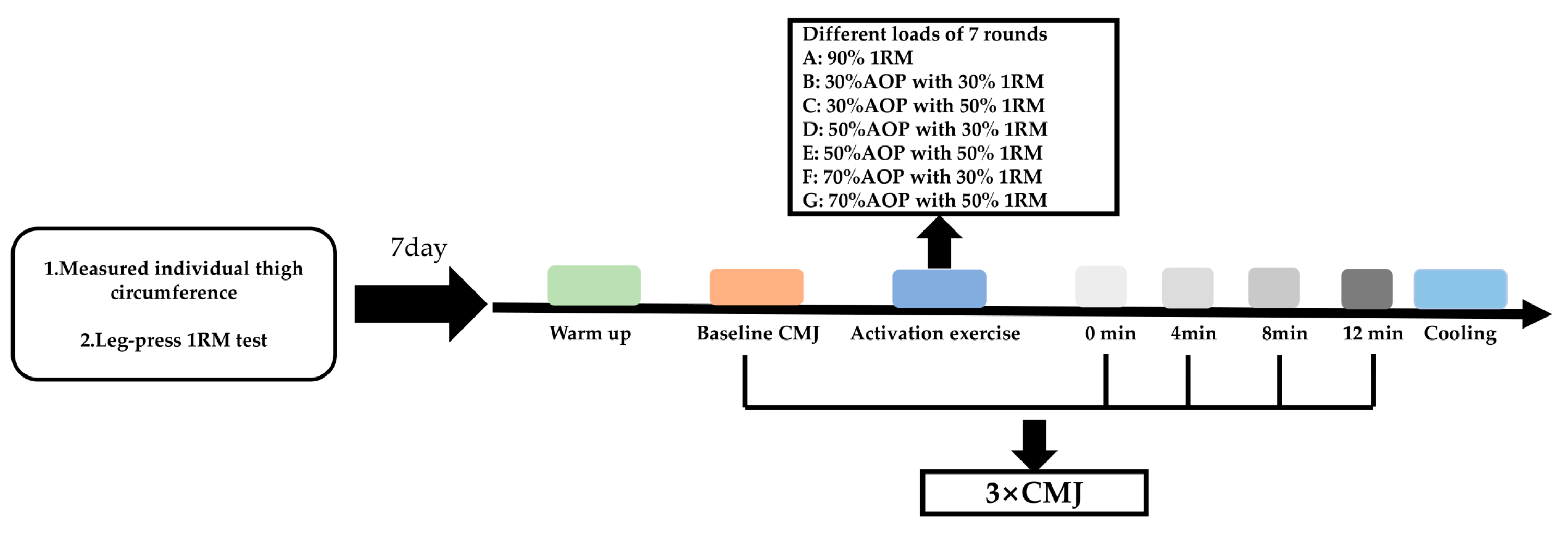
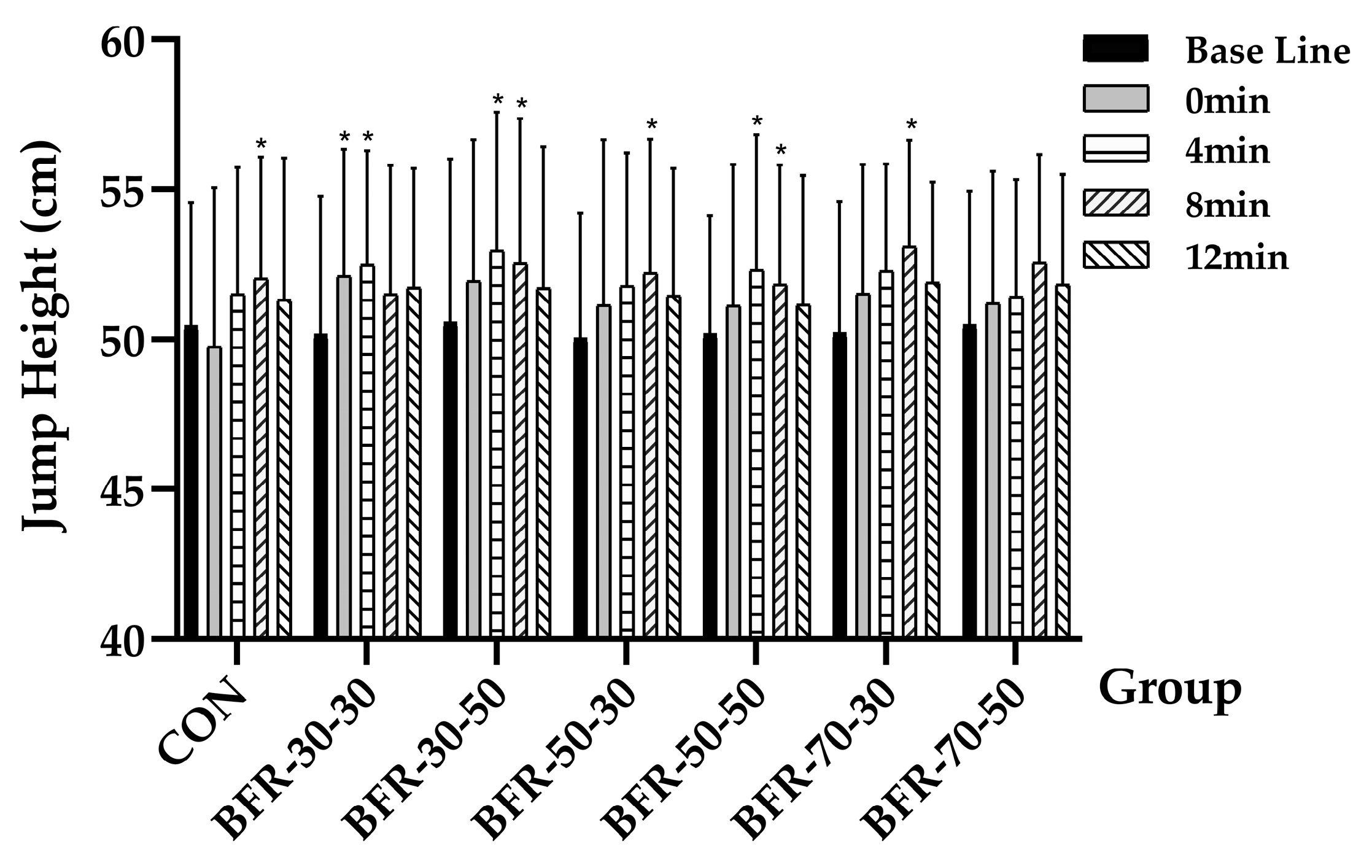
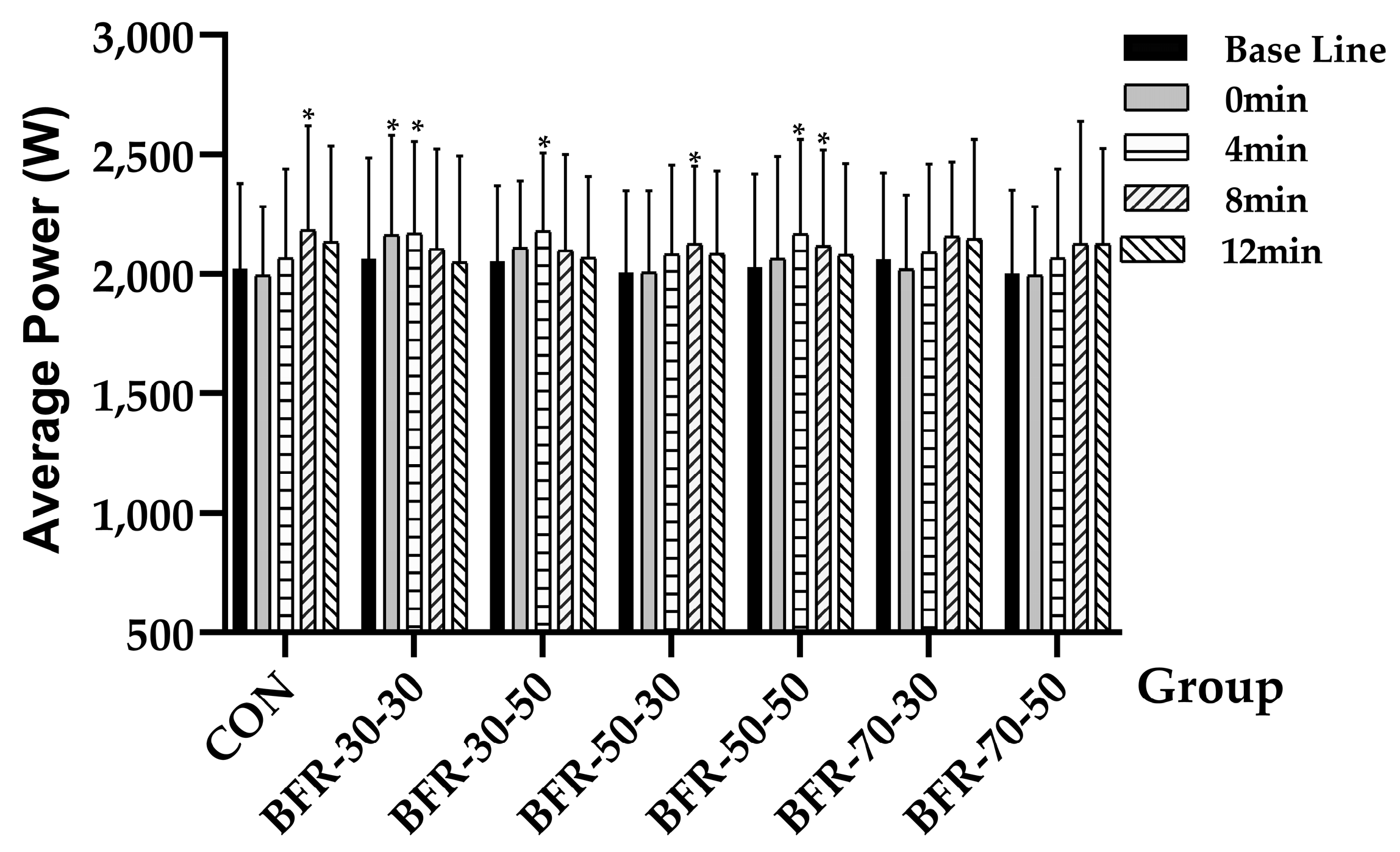
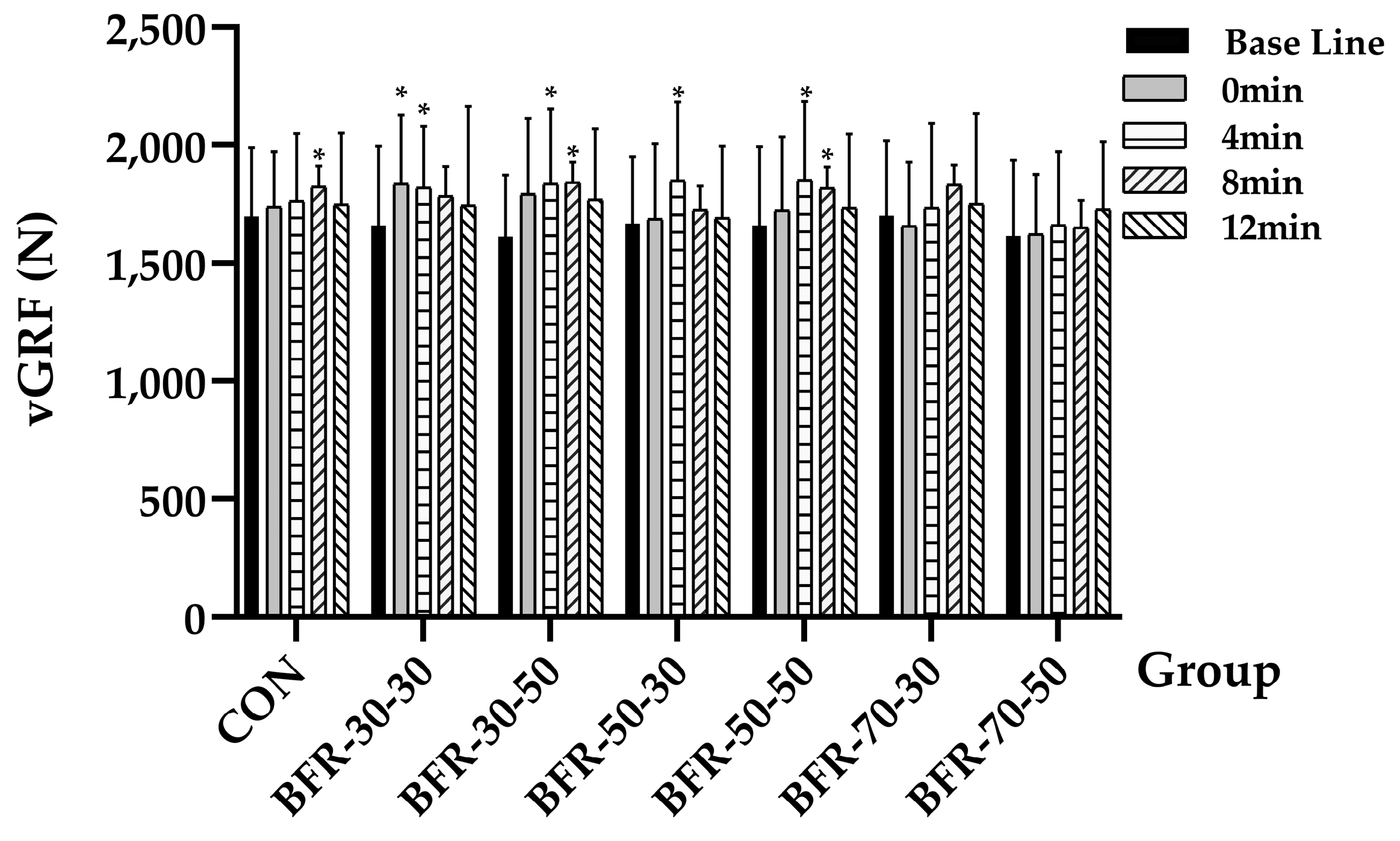
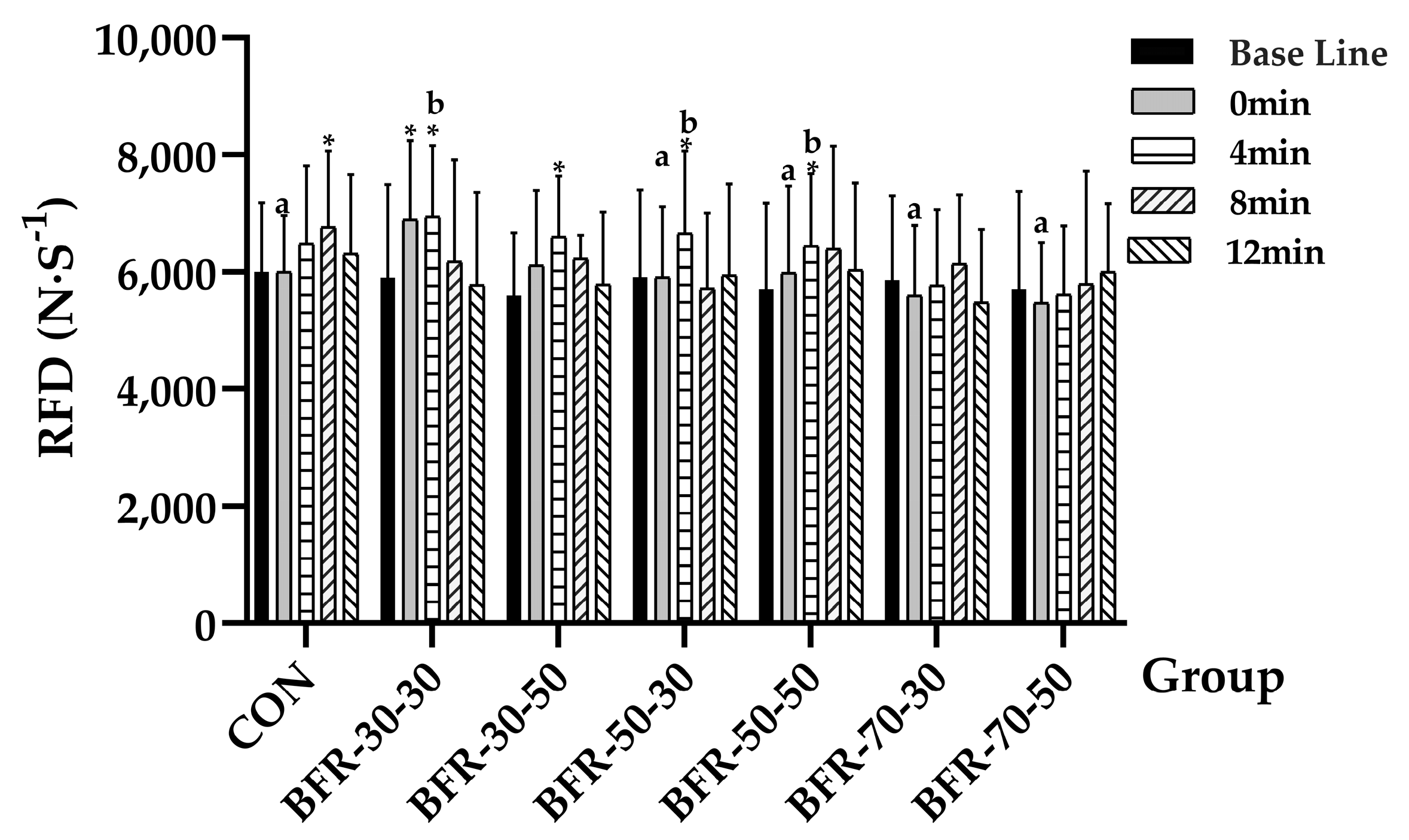
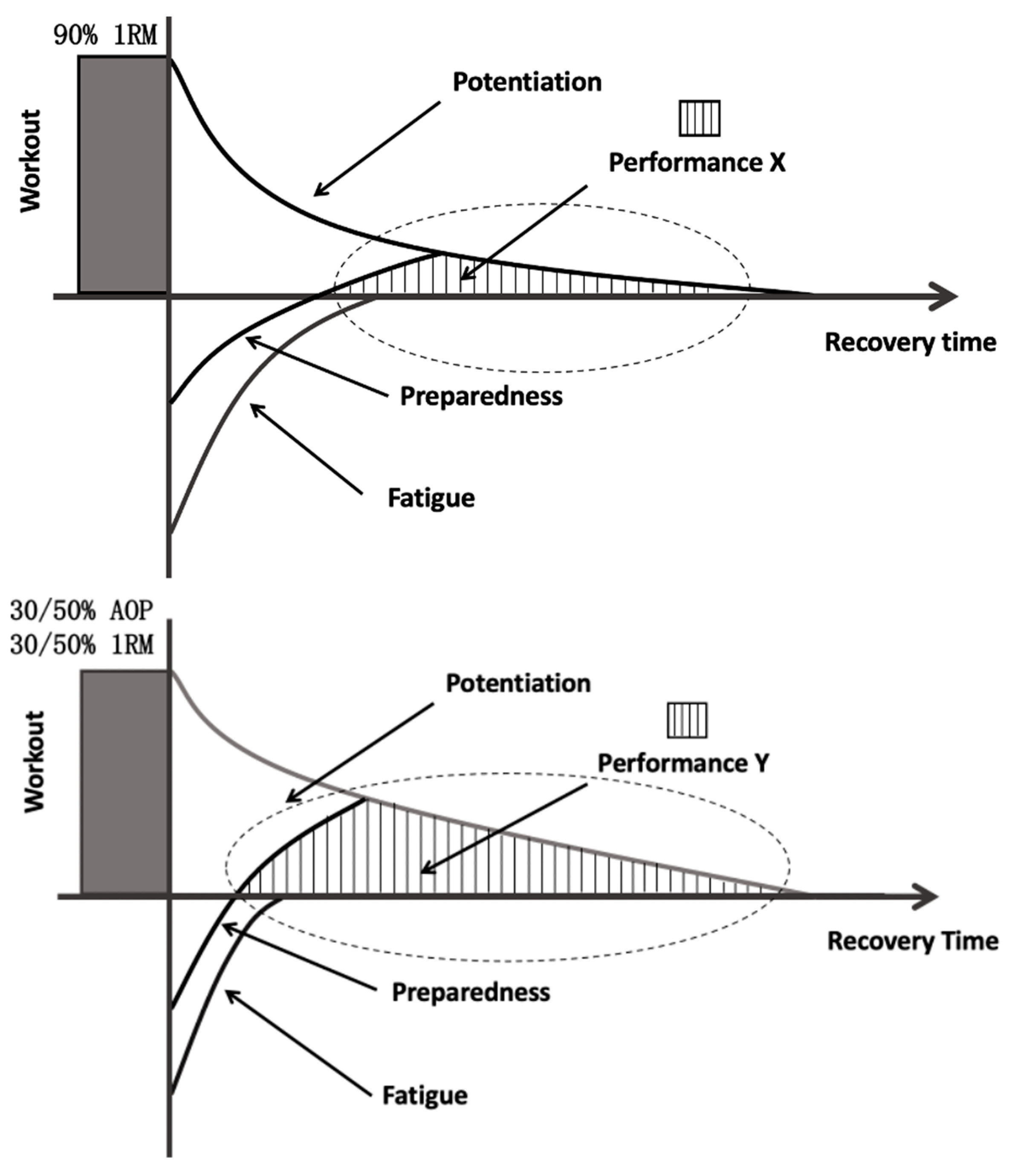
| Variables | Means ± SD |
|---|---|
| Age (y) | 22.7 ± 2 |
| Height (m) | 1.76 ± 3.82 |
| Mass (kg) | 66.7 ± 8.34 |
| BMI (kg/cm−2) | 22.35 ± 4.03 |
Publisher’s Note: MDPI stays neutral with regard to jurisdictional claims in published maps and institutional affiliations. |
© 2022 by the authors. Licensee MDPI, Basel, Switzerland. This article is an open access article distributed under the terms and conditions of the Creative Commons Attribution (CC BY) license (https://creativecommons.org/licenses/by/4.0/).
Share and Cite
Zheng, H.; Liu, J.; Wei, J.; Chen, H.; Tang, S.; Zhou, Z. The Influence on Post-Activation Potentiation Exerted by Different Degrees of Blood Flow Restriction and Multi-Levels of Activation Intensity. Int. J. Environ. Res. Public Health 2022, 19, 10597. https://doi.org/10.3390/ijerph191710597
Zheng H, Liu J, Wei J, Chen H, Tang S, Zhou Z. The Influence on Post-Activation Potentiation Exerted by Different Degrees of Blood Flow Restriction and Multi-Levels of Activation Intensity. International Journal of Environmental Research and Public Health. 2022; 19(17):10597. https://doi.org/10.3390/ijerph191710597
Chicago/Turabian StyleZheng, Hang, Jiajun Liu, Jia Wei, Hui Chen, Shan Tang, and Zhexiao Zhou. 2022. "The Influence on Post-Activation Potentiation Exerted by Different Degrees of Blood Flow Restriction and Multi-Levels of Activation Intensity" International Journal of Environmental Research and Public Health 19, no. 17: 10597. https://doi.org/10.3390/ijerph191710597
APA StyleZheng, H., Liu, J., Wei, J., Chen, H., Tang, S., & Zhou, Z. (2022). The Influence on Post-Activation Potentiation Exerted by Different Degrees of Blood Flow Restriction and Multi-Levels of Activation Intensity. International Journal of Environmental Research and Public Health, 19(17), 10597. https://doi.org/10.3390/ijerph191710597





